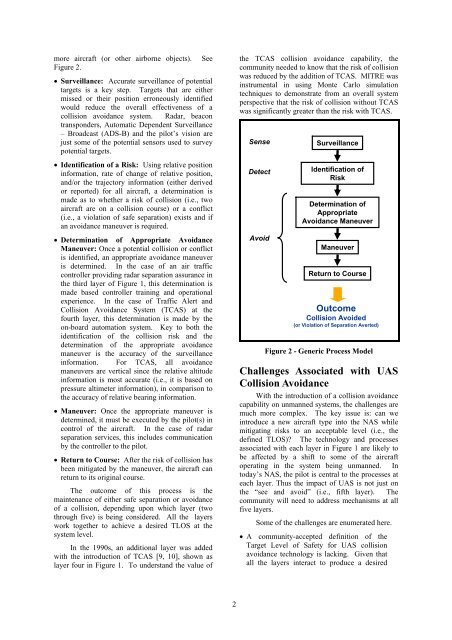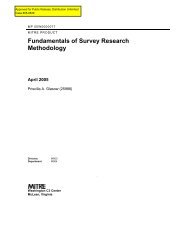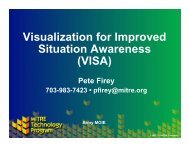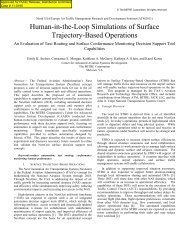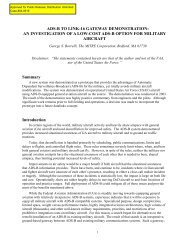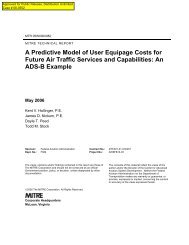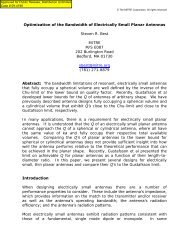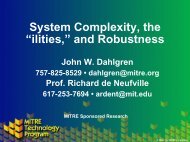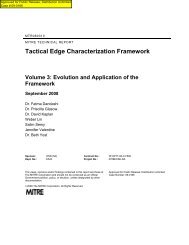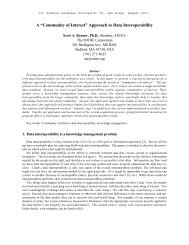Unmanned Aircraft Collision Avoidance: Technology ... - Mitre
Unmanned Aircraft Collision Avoidance: Technology ... - Mitre
Unmanned Aircraft Collision Avoidance: Technology ... - Mitre
You also want an ePaper? Increase the reach of your titles
YUMPU automatically turns print PDFs into web optimized ePapers that Google loves.
more aircraft (or other airborne objects). See<br />
Figure 2.<br />
• Surveillance: Accurate surveillance of potential<br />
targets is a key step. Targets that are either<br />
missed or their position erroneously identified<br />
would reduce the overall effectiveness of a<br />
collision avoidance system. Radar, beacon<br />
transponders, Automatic Dependent Surveillance<br />
– Broadcast (ADS-B) and the pilot’s vision are<br />
just some of the potential sensors used to survey<br />
potential targets.<br />
• Identification of a Risk: Using relative position<br />
information, rate of change of relative position,<br />
and/or the trajectory information (either derived<br />
or reported) for all aircraft, a determination is<br />
made as to whether a risk of collision (i.e., two<br />
aircraft are on a collision course) or a conflict<br />
(i.e., a violation of safe separation) exists and if<br />
an avoidance maneuver is required.<br />
• Determination of Appropriate <strong>Avoidance</strong><br />
Maneuver: Once a potential collision or conflict<br />
is identified, an appropriate avoidance maneuver<br />
is determined. In the case of an air traffic<br />
controller providing radar separation assurance in<br />
the third layer of Figure 1, this determination is<br />
made based controller training and operational<br />
experience. In the case of Traffic Alert and<br />
<strong>Collision</strong> <strong>Avoidance</strong> System (TCAS) at the<br />
fourth layer, this determination is made by the<br />
on-board automation system. Key to both the<br />
identification of the collision risk and the<br />
determination of the appropriate avoidance<br />
maneuver is the accuracy of the surveillance<br />
information. For TCAS, all avoidance<br />
maneuvers are vertical since the relative altitude<br />
information is most accurate (i.e., it is based on<br />
pressure altimeter information), in comparison to<br />
the accuracy of relative bearing information.<br />
• Maneuver: Once the appropriate maneuver is<br />
determined, it must be executed by the pilot(s) in<br />
control of the aircraft. In the case of radar<br />
separation services, this includes communication<br />
by the controller to the pilot.<br />
• Return to Course: After the risk of collision has<br />
been mitigated by the maneuver, the aircraft can<br />
return to its original course.<br />
The outcome of this process is the<br />
maintenance of either safe separation or avoidance<br />
of a collision, depending upon which layer (two<br />
through five) is being considered. All the layers<br />
work together to achieve a desired TLOS at the<br />
system level.<br />
In the 1990s, an additional layer was added<br />
with the introduction of TCAS [9, 10], shown as<br />
layer four in Figure 1. To understand the value of<br />
2<br />
the TCAS collision avoidance capability, the<br />
community needed to know that the risk of collision<br />
was reduced by the addition of TCAS. MITRE was<br />
instrumental in using Monte Carlo simulation<br />
techniques to demonstrate from an overall system<br />
perspective that the risk of collision without TCAS<br />
was significantly greater than the risk with TCAS.<br />
Sense<br />
Detect<br />
Avoid<br />
Surveillance<br />
Identification of<br />
Risk<br />
Determination of<br />
Appropriate<br />
<strong>Avoidance</strong> Maneuver<br />
Maneuver<br />
Return to Course<br />
Outcome<br />
<strong>Collision</strong> Avoided<br />
(or Violation of Separation Averted)<br />
Figure 2 - Generic Process Model<br />
Challenges Associated with UAS<br />
<strong>Collision</strong> <strong>Avoidance</strong><br />
With the introduction of a collision avoidance<br />
capability on unmanned systems, the challenges are<br />
much more complex. The key issue is: can we<br />
introduce a new aircraft type into the NAS while<br />
mitigating risks to an acceptable level (i.e., the<br />
defined TLOS)? The technology and processes<br />
associated with each layer in Figure 1 are likely to<br />
be affected by a shift to some of the aircraft<br />
operating in the system being unmanned. In<br />
today’s NAS, the pilot is central to the processes at<br />
each layer. Thus the impact of UAS is not just on<br />
the “see and avoid” (i.e., fifth layer). The<br />
community will need to address mechanisms at all<br />
five layers.<br />
Some of the challenges are enumerated here.<br />
• A community-accepted definition of the<br />
Target Level of Safety for UAS collision<br />
avoidance technology is lacking. Given that<br />
all the layers interact to produce a desired


